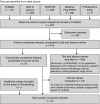Stakeholder views on secondary findings in whole-genome and whole-exome sequencing: a systematic review of quantitative and qualitative studies
- PMID: 27584911
- PMCID: PMC5447864
- DOI: 10.1038/gim.2016.109
Stakeholder views on secondary findings in whole-genome and whole-exome sequencing: a systematic review of quantitative and qualitative studies
Abstract
Purpose: As whole-exome sequencing (WES) and whole-genome sequencing (WGS) move into routine clinical practice, it is timely to review data that might inform the debate regarding secondary findings (SF) and the development of policies that maximize participant benefit.
Methods: We systematically searched for qualitative and quantitative studies that explored stakeholder views on SF in WES/WGS. Framework analysis was undertaken to identify major themes.
Results: Forty-four articles reporting the views of 11,566 stakeholders were included. Stakeholders were broadly supportive of returning "actionable" findings, but definitions of actionability varied. Stakeholder views on SF disclosure exist along a spectrum: potential WES/WGS recipients' views were largely influenced by a sense of rights, whereas views of genomics professionals were informed by a sense of professional responsibility. Experience with genetic illness and testing resulted in greater caution about SF, suggesting that truly informed decisions require an understanding of the implications and limitations of WES/WGS and possible findings.
Conclusion: This review suggests that bidirectional interaction during consent might best facilitate informed decision making about SF and that dynamic forms of consent, allowing for changing preferences, should be considered. Research exploring views from wider perspectives and from recipients who have received SF is critical if evidence-based policies are to be achieved.Genet Med 19 3, 283-293.
Figures
References
-
- Shkedi-Rafid S, Dheensa S, Crawford G, Fenwick A, Lucassen A. Defining and managing incidental findings in genetic and genomic practice. J Med Genet 2014;51:715–723. - PubMed
-
- Presidential Commission for the Study of Bioethical Issues. Anticipate and Communicate: Ethical Management of Incidental and Secondary Findings in the Clinical, Research, and Direct-to-Consumer Contexts. 2013. http://bioethics.gov/ sites/default/files/FINALAnticipateCommunicate_PCSBI_0.pdf.Accessed 1 May 2016. - PubMed
Publication types
MeSH terms
Grants and funding
LinkOut - more resources
Full Text Sources
Other Literature Sources
Molecular Biology Databases
Research Materials



